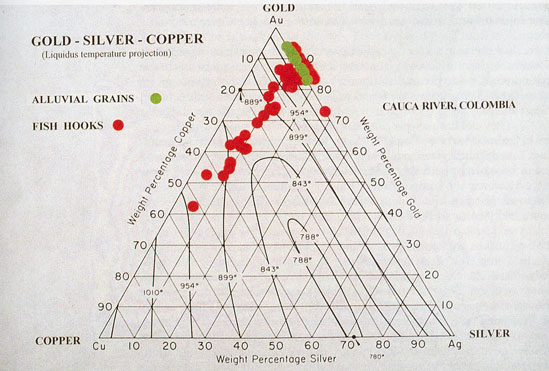 Gold and silver unite in all proportions, yielding alloys which are harder, more fusible, and more elastic than either metal. The hardest is that containing two parts of gold to one of silver. The colour of gold is sensibly lowered by the addition of very small quantities of silver, and on increasing the proportion of the latter, the colour changes by tints of a greenish-yellow (when from 20 to 40 per cent, of silver is present) to white, with a scarcely perceptible yellow tinge (when 50 per cent, of silver is present), and silver-white (when more than 60 per cent, of silver is present). Pearce has obtained in regular octahedra the alloys corresponding to the formulae Au8Ag, Au6Ag, and Au2Ag by liquation, and Levol has obtained AuAg, AuAg2, and AuAg5 in perfectly definite homogeneous forms. The alloys containing small quantities (less than 20 per cent.) of gold liquate readily if kept for some time in a state of quiet fusion, an alloy containing one part of gold to five parts of silver (AuAg9) sinking to the bottom, and slightly auriferous silver floating at the top. The silver-gold alloys most used in jewellery are green gold (silver 25, gold 75), dead-leaf gold (silver 30, gold 70), and the alloy containing 40 per cent, of silver. Triple alloys of gold, silver, and copper are employed far more frequently by English jewellers than those last mentioned; of these the alloys, consisting of 22-, 18-, 15-, 12-, and 9-carat gold respectively, can be hallmarked. Alloys of gold and silver were much used for coinage before the methods of parting became well known and inexpensive.
Gold and silver unite in all proportions, yielding alloys which are harder, more fusible, and more elastic than either metal. The hardest is that containing two parts of gold to one of silver. The colour of gold is sensibly lowered by the addition of very small quantities of silver, and on increasing the proportion of the latter, the colour changes by tints of a greenish-yellow (when from 20 to 40 per cent, of silver is present) to white, with a scarcely perceptible yellow tinge (when 50 per cent, of silver is present), and silver-white (when more than 60 per cent, of silver is present). Pearce has obtained in regular octahedra the alloys corresponding to the formulae Au8Ag, Au6Ag, and Au2Ag by liquation, and Levol has obtained AuAg, AuAg2, and AuAg5 in perfectly definite homogeneous forms. The alloys containing small quantities (less than 20 per cent.) of gold liquate readily if kept for some time in a state of quiet fusion, an alloy containing one part of gold to five parts of silver (AuAg9) sinking to the bottom, and slightly auriferous silver floating at the top. The silver-gold alloys most used in jewellery are green gold (silver 25, gold 75), dead-leaf gold (silver 30, gold 70), and the alloy containing 40 per cent, of silver. Triple alloys of gold, silver, and copper are employed far more frequently by English jewellers than those last mentioned; of these the alloys, consisting of 22-, 18-, 15-, 12-, and 9-carat gold respectively, can be hallmarked. Alloys of gold and silver were much used for coinage before the methods of parting became well known and inexpensive.
Electrum, which includes pale yellow alloys with from 15 to 35 per cent, of silver, and which occurs native, was much used for ornaments and coins by the Greeks and Romans, and by the nations which acquired their arts. The use of silver in the gold-copper coinage alloys was not discontinued until quite recently, all English guineas and the Australian sovereigns manufactured at Sydney up to the year 1871 containing some of it. Both nitric and sulphuric acids attack silver-gold alloys, almost completely dissolving out the silver if it is present in amounts variously stated at from 60 to 75 per cent, or over, while, if the proportion falls below 60 per cent., some of the silver is left undissolved with the gold. Hydrochloric acid scarcely attacks these alloys, and the action of aqua regia is soon arrested if the proportion of silver is considerable.
